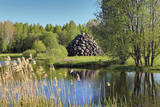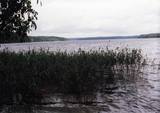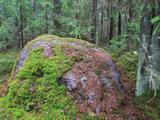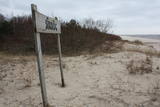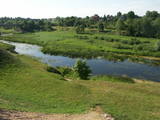| Нo | Название | Описание |
|---|---|---|
|
Organically certified farm. Produces greens, vegetables, micro-greens, vegetables and berry powder (gauze, balanda, dandelion, nettle, driven). Grown all year round. Offers product delivery in Riga, Valmiera, Cesis and Sigulda. |
||
|
Пивной ресторанчик находится на самой популярной пешеходной улице Юрмалы. Характерное для Юрмалы деревянное здание с милым интерьером, где предлагается латышская кухня. В предложении обширный выбор выпускаемого в Латвии разливного пива. Латышская кухня: Отбивные из салаки, котлеты из щуки, горшочек с бараниной в курземниекском вкусе, маринованные свиные ребрышки, жареная балтийская камбала, хлебный суп. |
||
|
Нагромождение валунов высотой 9 метров является своего рода памятником Кришьяну Барону и его достижениям на благо латышского народа. В Валпенском имении жила мать К. Барона и будущий Отец дайн. На камнях высечены названия исчезнувших домов. Их направление в каменной пирамиде указывает на бывшее местонахождение домов. Автор идеи Валпенской пирамиды – Имантс Зиедонис, скульптор – Вилнис Титанс. |
||
|
Ap 9,5 km garais un līdz kilometru platais ezers atrodas subglaciālā – t.i. ledāja veidotā vagā, tādēļ tas ir ne tikai Lietuvas, bet arī otrs Baltijas dziļākais ezers (pēc dažādiem avotiem 60,5 m vai 62,5 m). Tauragna dienvidu krastā paceļas Taurapils pilskalns (Taurapilio piliakalnis). Saglabājušies nostāsti gan par pagānu priesteri, kas te dzīvojis, gan nogrimušu baznīcu, gan laikiem, kad pilskalnu no visām pusēm apņēmis ūdens. No pilskalna plakuma paveras visaptverošs skats uz Tauragnu. |
||
|
По старинным торговым путям текли не только товары, но и знания и культура. Путь света связан со священником Эрнстом Глюком (Ernsts Gliks), литератором, переводчиком Библии и основателем школы для латышских детей, а также с гернгутерами – Карлисом Скалбе (Kārlis Skalbe), братьями Каудзитисами (brāļi Kaudzītes), Янисом Поруксом (Jānis Poruks), Антоном Аустриньшем (Antons Austriņš) и их духовным наследием. В Видземе пекут вкусный ржаной, ячменный, пшеничный и гречишный хлеб, а также хлеб из спельты. В тесто добавляют смесь различных семян, тмин, орехи, сухофрукты и конопляное семя. Из конопли готовят традиционную пасту, масло, пики с серым горохом, ее добавляют в конфеты «Коровка» и даже в шоколад. Пшеничную муку раньше использовали только по праздникам, в некоторых местах предлагают научиться печь из нее водяные крендели с солью и тмином. Путь зерна можно проследить в крестьянских хозяйствах и на восстановленных ветряных мельницах. Помимо традиционного Янова сыра попробуйте зеленый сыр и вкусные сыры из козьего молока. Местная гордость – судак из озера Буртниеку, выращенная здесь же форель, сомы и осетры, в сезон в некоторых местах предлагаются раки. Популярны блюда из мяса местной домашней птицы и скота, в том числе из крольчатины. Приусадебные кухни предлагают дичь и фазана с дарами леса и дикорастущими пряностями. В Видземе можно встретить Чесночную королеву и хозяйку, которая готовит порошки из растений. Попробуйте также пирожки, открытые пироги, медовый торт, десерты из взбитого творога, рябины, цидонии, яблок, сливок и ржаного хлеба, яблочные или черничные клецки. Жажду утолят травяные чаи с медом, березовый сок, ягодные лимонады или более крепкие напитки – вкусное пиво и вино. |
||
|
Кондитерская - кафе в Саулкрасты, недалеко от железнодорожной станции Саулкрасты. Предлагают выпускаемые изделия кондитерского магазина - пирожки, сдобные булочки, пирожные, кексы и блюда на все случаи жизни. В Саулкрасты на ул. Райня, д. 7, находится второе кафе. Латышская кухня: Холодный суп, рассол, квашеная капуста, домашние котлеты, серый горох с салом. Особое блюдо: Пиццы, приготовленные в дровяной печи. |
||
|
Находится в самом высоком месте, с красивым видом на окрестности. Одна из редких ветряных мельниц голландского типа в Латвии (1852 г.), которая находится в рабочем состоянии. Предлагают попробовать руку в помоле зерна. Каждый год в последнее воскресенье июля отмечают праздник Екаба – праздник молодого ржаного хлеба. Латышская кухня: Обед мельника - каша из ячменной муки с мясным соусом, тонкие блины, кефир, травяные чаи. |
||
|
В северной части Лигатне - Гауясмале расположена единственная и функционирующая в наши дни переправа через Гаую и единственная переправа в Балтии, работающая на силе течения. Переправа - транспортное средство местного масштаба. |
||
|
Лапмежциемский народный дом –
построен в 1957 г. В настоящее время здесь
находится волостное самоуправление и
библиотека. В народном доме проводятся
различные культурные мероприятия.
|
||
|
Подтоплены и находятся в месте слияния Даугавы и Персе. Возводился в 1209 году для нужд Рижского епископства на месте бывшей деревянной крепости древних латышей. В XIV веке во дворе замка были построены деревянные здания, приспособленные для постоянного проживания. В XVI веке построили пристройки и возвели две круглые башни. В 1701 году кажущийся несокрушимый замок взорвало войско саксонцев. Рядом с руинами замка работает центр для посетителей, в котором можно выковать монету средневековья и взять напрокат лодку для прогулки по Даугаве. Стоит прогуляться по Кокнескому парку (создан в 1900 г.), где установлены шведские пушкиXVII века, надгробные памятники средневековья и восстановлен фонтан «Голова фавна», который в 20 - 30 годах располагался неподалеку от водопада Персе (сейчас под водой). |
||
|
The owner of this farm produces ecological vegetables, fruits and berries, and two protected breeds of cows. She chairs a club for lovers of horses and breeds local breeds of horses. The owner has a horse breeding museum with more than 1,000 exhibits. She also organises various celebrations for the Assumption of Mary festival, etc. |
||
|
Atrodas Rīgas – Daugavpils autoceļa (A 6) 118. kilometrā. |
||
|
Saimniecībā tiek audzētas gaļas šķirnes (Suffolkas) aitas un piena šķirnes (Ostfrīzijas) aitas. Ganāpmulka aizsardzībai saimniecībā strādā ar sargsuņiem, Pireneju kalnu suņiem, kas ir pasaulē arī plaši pazīstama suņu šķirne mājlopu un mājputnu apsargāšanai no lielākiem un mazākiem plēsējiem. Saimnieki piedāvā iegādāties premium klases, saimniecībā audzētu, jēru gaļu un aitu piena produktus- Fetas tipa sieru, grilsieru, jogurtu bez piedevām un vairāku veidu saldējumus. |
||
|
The Grandboulder of Komultēni is situated in Sakstagals rural municipality in the forests; around 700
m from Jēkabpils – Rezekne road to the NE of Komultēni. The flat top and the sides are cracked. Boulder consists
of the magmatized gneiss. The circuit of the boulder is 15 m, length 5 m, width 3 m, height 1.8 m,
capacity about 20 m3.
|
||
|
This is one of the oldest Livonian villages, recorded in documents for the first time in 1387. The old road from the Dundaga Estate to Sīkrags existed in the Middle Ages. During the 17th century, Sīkrags was one of the most important small ports in Northern Kurzeme, receiving ships from England, Holland and Lubeck that carried coal, grain and other products. Before World War I, there were five sprat smokehouses in the village, and some 55 fishermen lived there during the 1920s and 1930s. Among those to have been born in Sīkrags was the Livonian cultural activist Hilda Grīva (Cerbaha, 1910-1984), seafaring captain Kārlis Anbanks (1884-1937), Baptist preacher Kārlis Lāceklis (1904-1970), linguist and tradition specialist Pēteris Dambergs (1909-1987), and graphic artist Baiba Damberga (b 1957). Today the village is a cultural monument of national importance. It is crossed by a bike route, with a commemorative stone where the narrow-gauge railroad station once stood. Sīkrags, like neighbouring villages, is in the Slītere National Park. |
||
|
Medinski Vincīši boulder also called Magoņkalns (Poppy hill). Red rapakivi granite boulder is found
in the tree cluster only 40 m to the left of Jaunviļāni – Medinski road and about 40 m from the right side of
the river Malta. The boulder is 6,6 m long, 5,4 m wide and 3,3 m high. The circuit of the boulder is 20 m
and the volume 40 – 45 m3.
|
||
|
Četrus kilometrus gara marķēta lokveida taka, kas ved pa lielāku meža masīvu, iepazīstina ne tikai ar augiem un dzīvniekiem, bet arī mežsaimniecības tradīcijām. Takas sākums atrodas pie nelielā Perejerves ciema, uz kuru paveras labs skats no tuvējā paugura. Pie autostāvlaukuma izveidota atpūtas un piknika vieta. |
||
|
The Bauska Nature Park runs for several dozen kilometres along the Lielupe River and its tributaries – the Mūsa and the Mēmele. This is a protected territory. The shores of these rivers contain some of the largest dolomite cliffs in Zemgale. These are protected both as biotopes and as geological monuments. The rivers are important places for river lampreys and vimbas to spawn. Tourists will be attracted by the cultural landscape of the area, as well as the cultural monuments such as the Bauska castle, the Jumpravmuiža park, the Mežotne castle hill, Vīna Hill, the Mežotne castle, etc. The rivers are used for water tourism. |
||
|
Together with Valga on Estonian side - a peculiar frontier twin town. |
||
|
To the East of the Ezermuiža-Dūmele road you will find the bed of the ancient Lake Dieviņezers. It was one of the largest lakes in Kurzeme in the past, being 7.5 km long and 1.6 km wide. A canal was dug in 1838 (Melnsilupe River today), and the water from the lake was siphoned to the sea so as to create fertile farmland. Residents of Ezermuiža have been involved in forestry work since the age when barons ruled the land. Dūmele is connected to Košrags by a lonely forest road that is known as the Bottom Road. A bike route runs down it. The Ziedkalni weekend house is in Dūmele. The "Ziedkalni" homestead in Dūmele offers spa services, cod fishing and accommodations. |
||



